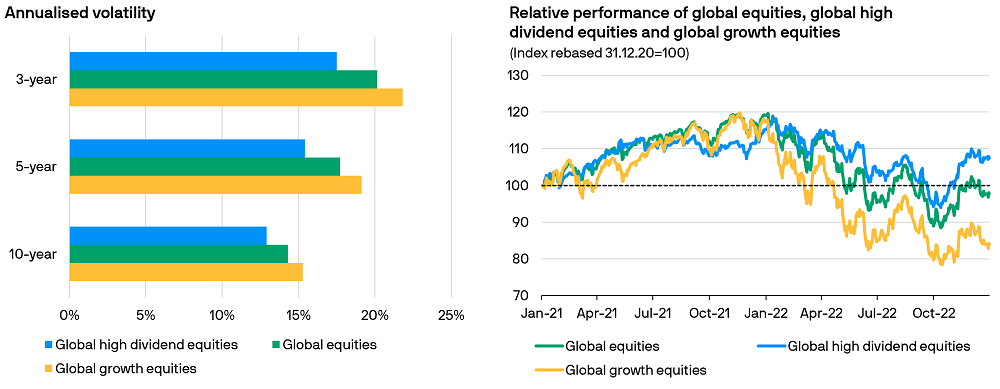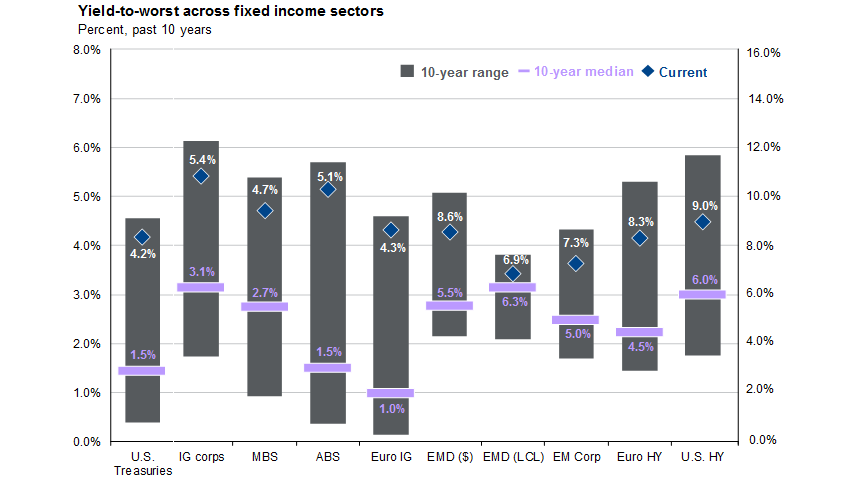What are active ETFs?
Active ETFs explained in 1 min
Key takeaways:
The sweet spot between caution and optimism
Investment markets are off to a good start. China’s reopening, moderating US inflation and firming expectations of smaller interest rate hikes by the Federal Reserve have seemingly prompted a turn in market sentiment.
Among investors, some may be considering the prospect of dialling up risk in portfolios to make the most of the recovering market sentiment. Yet there are risks ahead. Aggressive monetary policy tightening has increased the risks of a downturn in the US, while China may be facing some challenges in the transition towards living with COVID-19. Elevated economic uncertainty may keep markets volatile for some time.
Against these considerations, investors could be searching for ways to harness opportunities in a recovering market without piling on the risks. Income investing can be one option. It presents a middle ground of opportunities that can help investors capture broader market upside while providing buffer through cash flows from income generating assets such as bonds and dividend-paying stocks to help ride through volatile times.
Dividend-paying stocks: more than just a source of income
Dividend-paying stocks have historically exhibited lower volatility versus the broader index and growth stocks. As illustrated below, the annualised volatility of the MSCI ACWI High Dividend Yield Index has consistently stayed lower than the MSCI ACWI Growth Index across different time periods.
This low volatility characteristic, coupled with meaningfully higher dividend yields relative to its growth peers, have contributed to the outperformance of dividend paying equities over the last two years. Given the uncertain economic backdrop, dividend paying equities could still play an important role for portfolios.
High dividend stocks tend to exhibit lower volatility relative to its growth peer. It has also outperformed the broader index over the last two years.

Source: Bloomberg, J.P. Morgan Asset Management. Data as of 31.12.2022. Global equities represented by MSCI All Country World Index (MSCI ACWI). Global high dividend equities represented by MSCI ACWI High Dividend Yield Index. Global growth equities represented by MSCI ACWI Growth Index. Provided for information only to illustrate macro trends, not to be construed as research or investment advice. Investments involve risks. Not all investments are suitable for all investors. Indices do not include fees or operating expenses and are not available for actual investment. Past performance is not indicative of current or future results.Yield is not guaranteed. Positive yield does not imply positive return.
Fixed income is fashionable again
Bonds are generally the foundation of any income portfolio. After a year of significant repricing in bond markets, as illustrated below, yields across various fixed income sectors have risen to decade highs due to monetary policy tightening by major central banks. This illustrates the role of fixed income in portfolios as higher yields may bring in opportunities for higher investment income and may potentially serve as a hedge to help manage recession risks.

IG = investment grade. HY = High yield. EMD (LCL) = Emerging market (Local currencies). Source: Bloomberg, J.P. Morgan Asset Management. Data as of 31.12.2022. Provided for information only to illustrate macro trends, not to be construed as research or investment advice. Investments involve risks. Not all investments are suitable for all investors. Indices do not include fees or operating expenses and are not available for actual investment.Past performance is not indicative of current or future results.Yield is not guaranteed. Positive yield does not imply positive return.
Stay diversified, stay flexible, stay active
Amid a fluid market environment, it is important to engage risk mindfully and prudently. Income investing can help tap investment opportunities while managing volatility via potentially steady cash flows from a diversified portfolio of income generating assets. It presents a more durable, long-term approach to revisiting market opportunities as silver linings emerge after a difficult 2022.
The flexibility to capture opportunities within and across asset classes, sectors and geographies as well as dynamically adjust portfolio allocation is essential to navigate the cross currents in an uncertain market environment. Active duration management in response to a changing interest rate environment is also critical to steer fixed income portfolios during a period of high inflation and slowing growth.
Provided for information only based on market conditions as of date of publication, not to be construed as offer, research or investment recommendation or advice. Forecasts, projections and other forward looking statements are based upon current beliefs and expectations, may or may not come to pass. They are for illustrative purposes only and serve as an indication of what may occur. Given the inherent uncertainties and risks associated with forecast, projections or other forward statements, actual events, results or performance may differ materially from those reflected or contemplated.
Diversification does not guarantee investment return and does not eliminate the risk of loss. The portfolio risk management process includes an effort to monitor and manage risk, but does not imply low risk.
This advertisement or publication has not been reviewed by the Monetary Authority of Singapore. It does not constitute investment advice, or an offer to sell, or a solicitation of an offer to buy any security, investment product or service. Informational sources are considered reliable but you should conduct your own verification of information contained herein. Investments involve risks. Investments are not similar or comparable to deposits. Past performance is not indicative of current or future performance and investors may not get back the full or any part of the amount invested. Dividend distributions if any are not guaranteed and are made at the manager’s discretion.Fund’s net asset value may likely have high volatility due to its investment policies or portfolio management techniques. The value of the units in the scheme and the income accruing to the units, if any, may fall or rise. Funds which are invested in emerging markets, smaller companies and financial derivative instruments may also involve higher risks and are usually more sensitive to price movements. Any applicable currency hedging process may not give a precise hedge and there is no guarantee that any hedging will be successful. Investors in a currency hedged fund or share class may have exposure to currencies other than the currency of their fund or share class. Investors should make their own investigation or evaluation or seek independent advice prior to making any investment. Please refer to the Singapore Offering Documents (including the risk factors set out therein) and the relevant Product Highlights Sheet for details at https://am.jpmorgan.com/sg/en/asset-management/per/. To the extent permitted by applicable law, we may record telephone calls and monitor electronic communications to comply with our legal and regulatory obligations and internal policies. Personal data will be collected, stored and processed by J.P. Morgan Asset Management in accordance with https://am.jpmorgan.com/sg/en/asset-management/per/privacy-statement/. Issued by JPMorgan Asset Management (Singapore) Limited (Co. Reg. No. 197601586K). All rights reserved.